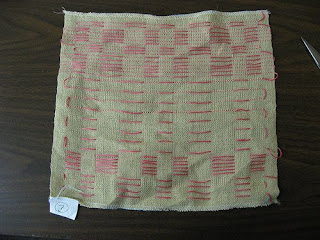As promised, a free pattern for the socks in the last post. You can use fingering weight or sportweight for this one. Worsted weight works as well if you switch to size 3 needles. Only uses a little bit, 10-15 grams per pair, great for using up leftovers!
Update: Turns out they are too small for an actual baby (sorry, Lori) so I changed the name. Might fit a preemie, though. Great for ornaments!
Toe-Up Sock Ornaments
Using eastern cast-on and size 2 dpns, wrap 2 double-pointed needles 6 times (6 sts on each needle). Knit top needle stitches onto another needle, then turn and knit first three stitches onto one needle and last three stitches onto a different needle. Place a marker (I use a coilless pin).
Round 1: (k1, m1, k4, m1, k1) 2 times
Round 2: knit
Round 3: (K1, m1, k6, m1, k1) 2 times
Round 4: knit
Round 5: (K1, m1, k8, m1, k1) 2 times
There are now 24 stitches. Knit 20 rounds.
Rearrange the stitches onto 4 double points, 6 stitches on each one.
For the short row heel, work as follows:
Row 1: k11, turn
Row 2: backwards yo, p10, turn
Row 3: yo, k9, turn
Row 4: backwards yo, p8, turn
Row 5: yo, k7, turn
Row 6: backwards yo, p6, turn
Row 7: yo, k5, turn
Row 8: backwards yo, p4, turn
Row 9: yo, k4, rev mount of yo, knit together with next stitch (k2tog). Turn.
Row 10: backwards yo, p5, slip yo as if to knit, slip next stitch as if to knit, purl yo and slipped stitch together through the back loops (p2togtbl). Turn.
Row 11: regular yo, knit 6, rev mount of yo, slip next yo as if to knit, knit together with next stitch (k3tog). Turn.
Row 12: backwards yo, purl 7, slip yo as if to knit, slip next yo as if to knit, slip next stitch as if to knit, purl both yo's and slipped stitch together through the back loops (p3togtbl). Turn.
Row 13: regular yo, knit 8, k3tog as in row 11. Turn.
Row 14: backwards yo, purl 9, p3togtbl as in row 12. Turn.
Row 15: regular yo, knit 10, k3tog as in row 11. Turn.
Row 16: backwards yo, purl 11, p3togtbl as in row 12. Turn.
Next round: regular yo, knit 12. reverse mount of yo, make 1 stitch between yo and next stitch. Knit yo, make 1 and next stitch together (k3tog). knit 10. Slip next stitch as if to knit. Make 1 between slipped stitch and next yo. Slip yo as if to purl. Knit slipped stitch, make 1 and yo together through the back loops.
Knit 4 rounds. Switch to knit 1, purl 1 rib and knit 20 rounds. Cast off as you like. I usually use a tubular bind off.
Pattern Key:
k knit
p purl
m1 make 1 stitch by lifting the yarn between the
stitch you just worked and the next stitch
onto the left needle and knitting it.
yo yarn over with leading leg in front of needle.
backwards yo yarn over with leading leg behind needle.
rev mount reverse mount of stitch so the leading leg is in front of needle.
slip move from left needle to right needle without working stitch.
k2tog knit 2 stitches together
p3togtbl purl 3 together through the back loops.





















































